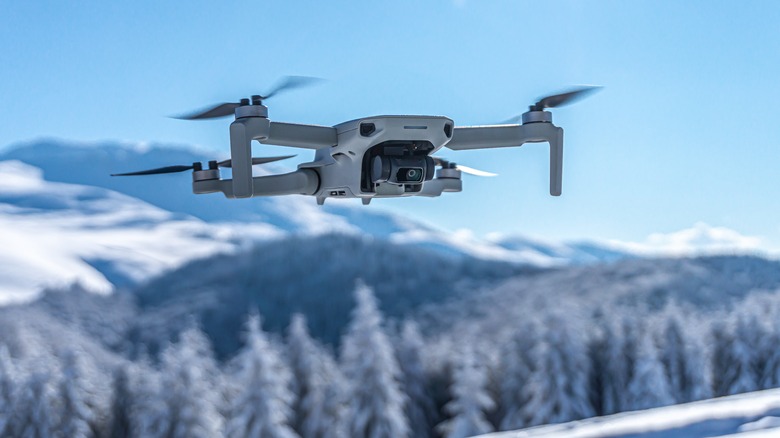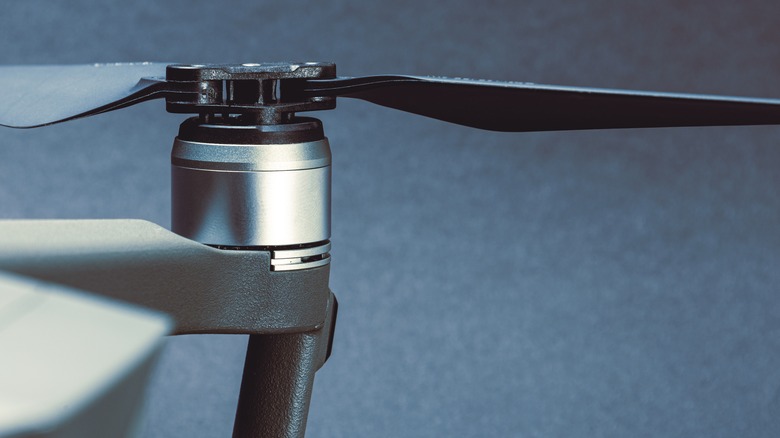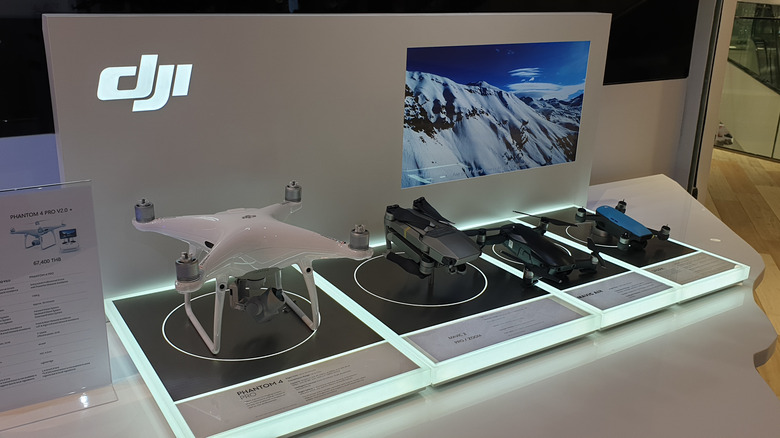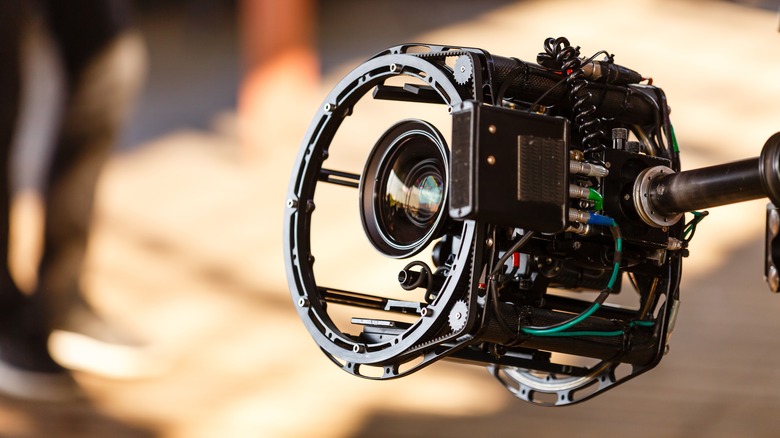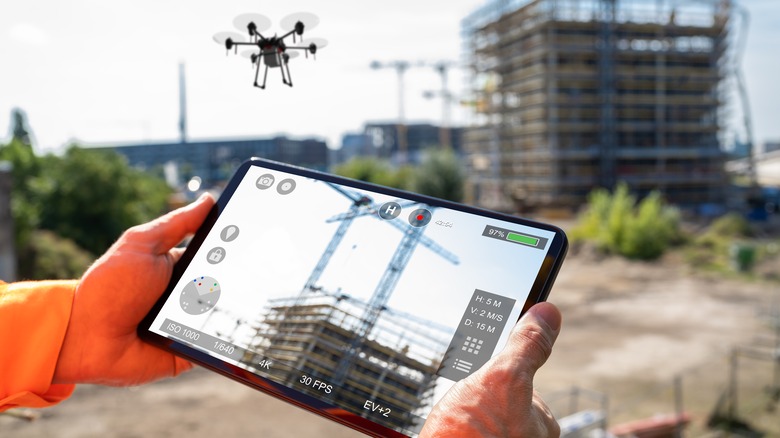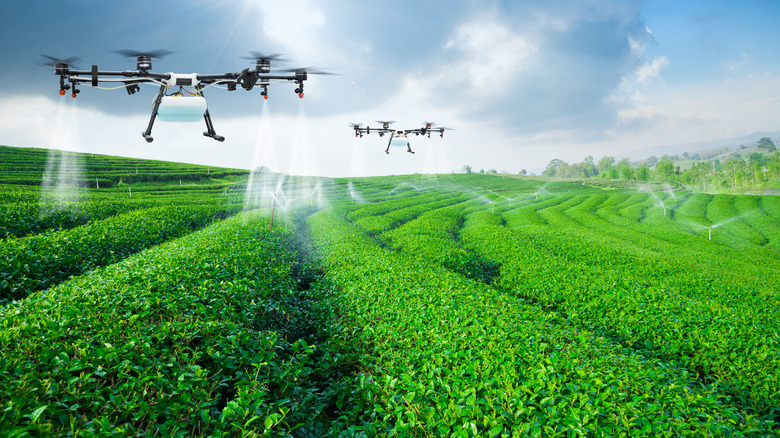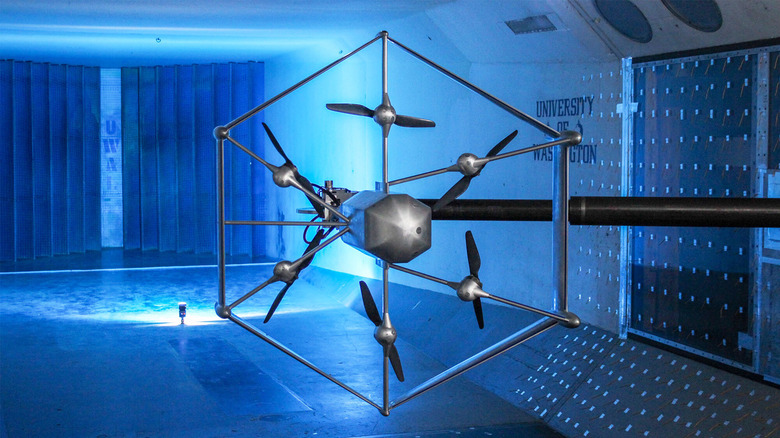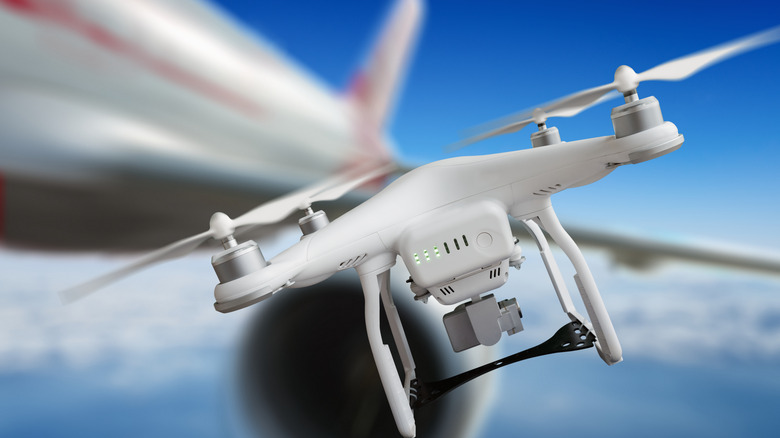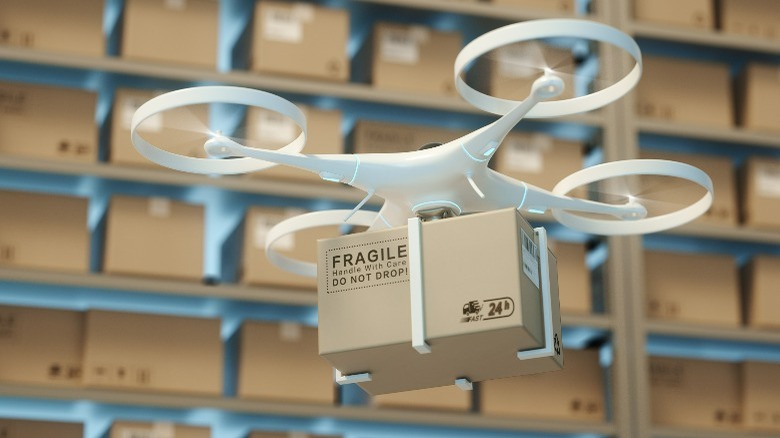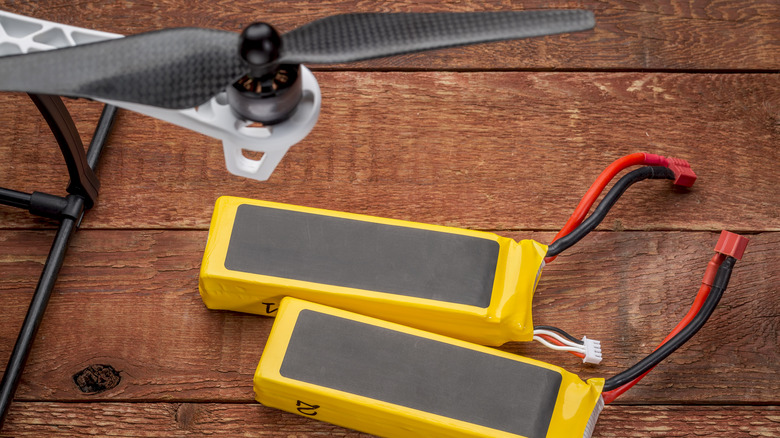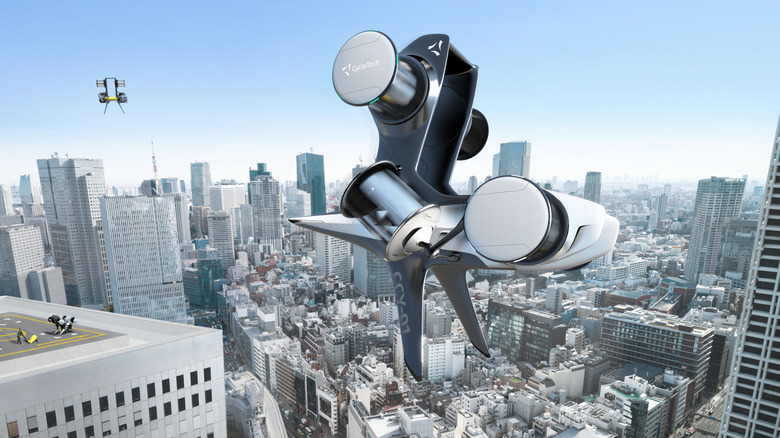The Biggest Ways Drones Have Evolved Over The Years
When you consider that the first commercially viable consumer drone hit the shelves in 2010, it was at once amazing and maybe an understatement when Interesting Engineering speculated that we might be in the "golden age" of drone tech. Drones are improving dramatically and rapidly. Toy drones have already become both cheap and good; prosumer models have done so well that they've generated a glut of drone photographers and licensed pilots, and there's no limit to the commercial and military purposes for which drones are being deployed.
This sudden (if predictable) success of drones was the result of a perfect storm of many convergent factors. The timing of the biggest players in consumer and prosumer drones was impeccable, leading to the launch of the most influential products between 2010 and 2013. Meanwhile, the smartphone market was also exploding, which contributed to lower prices and the broader availability of microcontrollers and sensors that were relevant to drones.
Overseas companies and a strong hobbyist community (reminiscent of the early days of 3D printing) advanced innovations while U.S. companies were hamstrung by what was effectively a regulatory ban on commercial drones between 2007 and 2016 (via Rotor Drone Pro). Finally, in 2016 the FAA issued 14 CFR Part 107, enabling commercial drones to operate in U.S. skies. Though this didn't actually resolve many regulatory issues, within about a month, 80,000 commercial and government drones were registered with the FAA, kicking off an immediately healthy commercial drone industry.
How we (crash) landed here
Around the time of the U.S. Civil War, the most notable unmanned aerial vehicles were flaming balloons that had been set aloft by Austria to burn Vienna, according to Monash University's Centre for Telecommunications and Information Engineering (CTIE). A shift in the wind took these "drones" off course, a story familiar to any modern toy drone owner who has retrieved hers from a tree on a gusty day. Lots of experts cite this as the first appearance of drones, but there are dozens of other candidates as well, depending on how you define "drone."
If you're tempted to start drone history with quadcopters, keep in mind that the first four-rotor vehicle, given the somewhat obvious name "Gyroplane Number 1," was tested in 1907 according to Krossblade Aerospace. Gyroplane Number 1 wasn't unmanned, but it was certainly a progenitor of the devices you now find in the car trunks of many wedding photographers, realtors, and documentarians.
Modern non-military drone history began in earnest once computers were advanced and miniaturized enough to make small, stable multi-copters possible, maybe with the 1999 introduction of the Draganflyer Quad Helicopter, which sparked a hobbyist craze culminating in Parrot's commercially successful AR.Drone in 2010. A lot of technological advancements along the way took the concept from an experiment to a commonplace product in less than a quarter of a century.
Just the form factors, ma'am
A few years ago, Air Drone Craze (a once-authoritative and now-defunct guide to all things drone) published a generational timeline of drone development that attempted to make sense of the larger arc of drone technologies. It shows most aspects of drone design being steadily revolutionized, yet the most obvious thing about drones — how they look — didn't change much from the earliest days of quadcopters until the mid-2010s. In fact, the only real form factor development mentioned in Air Drone Craze's taxonomy is the shift from "static design" to "transformative design," which seems to mean a move from classic multicopters toward multicopters you can fold up to some degree.
Safety concerns are behind some of the earliest moves away from the quadcopter format. The bi-rotor Cleo Dronut and the even more donut-like Cleo Drone were designed for indoor use, so the rotors are completely enclosed to protect people and things. It's also described as "collision tolerant," which it accomplishes without the geodesic-gyro-death-star cage (or the $20,000 price tag) of Flyability's Gimball or their more recent Elios 2.
A major current trend is toward miniaturization, which began with drone industry giant DJI's Mavic Pro and is made possible by increasing battery life, camera improvements, and obstacle avoidance technology. Called variously mini-, micro-, or nano-drones, these range from the ordinary-looking DJI Spark to the X-wing-starfighter-meets-biplane aesthetic of the Parrot Swing. They key advantage of mini-drones is, of course, portability — or even pocketability.
Stability for media capture and beyond.
Aside from models that specialize in crashing into neighbors' second-story windows, consumer drones have mostly been of three basic types for a few years: simple toys, racing drones, and drones used for photography and videography, with photo drones, arguably being the most important. And everyone agrees that the single most important evolution in drone photography tech has been the quest for the ideal gimbal. At least, the people who have heard of gimbals agree about this.
A gimbal is a device that keeps a camera or other equipment in a stable position as its platform (in this case, a drone) moves around. This is obviously critical for capturing photos and videos. As drones rapidly evolved from hobbyist fixed camera mounts to two- and three-axis gimbals to the current crop of 360-degree gimbals, drones began to be adopted by photographers, law enforcement, border control, safety inspectors, disaster management and rescue specialists, and others.
This all happened rather rapidly. The original and iconic DJI Phantom didn't have a gimbal at all, while the company's Zenmuse Z15-GH3, introduced about eight months later, had a three-axis gimbal. But without a good gimbal, drone photography was dead in the water.
Photography/videography imaging
Of course, no matter how great one's gimbal is, you still need a decent camera to take a good photo like the drone photo of Santuario Nacional de Cristo Rei you see above. The key factor in better photography, at least when it comes to drone photography, has been the size of the camera's sensor. Generally speaking, when you move beyond the standard 1/2.3-inch sensor used in many drones and point-and-shoot cameras, you start seeing better dynamic range in your photos and better low-light results, because the sensor simply takes in a lot more information.
While drone evolution has benefitted hugely from the synergistic relationship with camera phones, and particularly with their camera sensors, professional photography (particularly of the dramatic, striking type expected of drone photography) demands more. A 1-inch camera sensor produces great results, but those will be rare in smartphones because the lenses required to take advantage of such large sensors are prohibitively large.
Sensor size isn't the only factor in photography, of course. DxOMark rates camera sensors according to performance in color depth, dynamic range, and low-light situations. While sensor size is obviously important, their ratings show that size isn't a consistent predictor of quality, as the GoPro HERO5 Black was notably worse than the DJI Phantom 4's sensor, in spite of being the same size. Weight and space limitations for drones mean that, as a rule, hand-held cameras will almost always outperform drones with the same sensor size.
Blurred lines and semi-pro pilots
It seems a strange way to talk about a product's evolution, but there's no doubt that a lot of the same drone models serve the professional and consumer/hobbyist markets in the U.S., and to the extent, there's a difference between prosumer and professional models there's obviously a lot of cross-pollination. Consider DJI's Mavic line, for example, the consumer-grade Mavic 2 Zoom and the professional Mavic 2 Pro are identical save for the Hasselblad camera on the Pro. Similarly, the Mavic 2 Enterprise is substantially the same as the Zoom model, but with add-on modules for specific tasks.
Consumer and commercial drones were similar when relaxed FAA regulations first made business use of drones practical. In the first year of the Part 107 rules, the FAA registered 80,000 drones and licensed 60,000 pilots. Statista shows that same year, over 2.8 million personal drones were sold.
Control systems and invisible drones
You can see a clear line in the history of drone tech from remote control through autopiloting to automation and "smart drone" capabilities. This is one area in which commercial and consumer drones naturally tend to diverge over time. Smart tech that assists a human pilot will be welcomed by hobbyists, but the piloting itself will usually be a big part of the draw for consumers, so it wouldn't make sense to eliminate the human involvement.
Commercial interests, on the other hand, naturally foster technology to improve efficiency, which in most cases means automating what can be automated and excluding human labor (with its expenses and errors) wherever possible. In the Air Drone Craze model, drones evolved from basic control to manual piloting, then to assisted and autopilot modes, then to the current intelligent piloting modes. The next generation will see enhancements to intelligent piloting, and the advent of full drone autonomy during flight.
Full autonomy has recently been made possible by advancements in sensors, communications, hardware, and software. But an FAA requirement that commercial drone operators have a direct line of sight with their drones has, according to IBM, hampered commercial and industrial development. Fortunately, the FAA is testing small drone traffic management in order to form new regulations that will likely enable much broader Beyond Visual Line of Sight (BVLOS) drone operation, largely enabled by improved control systems.
Flight pathing and other verbings
The ability to either pre-plan or fabricate on-the-fly flight paths has long been a differentiating feature for drone manufacturers. Consider the "follow me" functionality popular among outdoors enthusiasts, or the trend toward dual embedded systems that leaves the pilot free to manipulate a camera while the drone follows a predetermined route.
From the very first Ar.Drone, onboard microcontrollers handled path planning and flight control functions using a processor significantly less powerful than today's cheap Raspberry Pi single-board computers. As available processing power has increased, so has the ability of the drone to construct more complex (and less labor-intensive) flight plans, while still managing basic functions and the complex, constant calculations and adjustments required by the thrust and angle systems of drones.
Waypoint GPS navigation is enabling multiple-stop deliveries – a key commercial application of drones — and GPS technology has driven much improvement in smart path planning. But more local information is a key to other aspects of flight planning, such as the immediate navigational needs of a drone participating in (or attacking, or evading) a drone swarm in obstacle-filled environments like a forest. This is obviously important for military applications, but also for other purposes like disaster recovery. Such advancements balance various drone requirements like lightness, computational power, safety, and managing flight times.
Avoiding obstacles, collisions, and annoying neighbors
If you know Arduino hobbyists who have played around with robotics, they will know about infrared obstacle avoidance sensors like the KY-032 and distance sensors like the HC-SR04. When you read about the DJI Mini 3 Pro's tri-directional obstacle sensing, this is the sort of technology involved, albeit taken to a different level. Miniaturization has made obstacle avoidance feasible for the Mini and other small drones like DJI's Spark, and coupled with sensor tech development (notably 3D LIDAR) makes new drone applications, such as inspections or mapping, practical.
Collision avoidance (and equivalent concepts like "obstacle avoidance," which presumably also involves steering clear of collisions) can be a strong differentiator, as with Yuneec's innovative pivot-mounted obstacle avoidance sensor, which entered the market competing with DJI's less capable fixed sensor. Autonomous collision avoidance is in its infancy but developing fast, and promising advancements are on the horizon. Vigilant Aerospace's FlightHorizon system has reportedly proven 100 percent effective in real-world tests, which has been validated by FAA analysis. DeTect, Sunhillo, Iris Automation, Echodyne, SageTech, and other companies all offer advanced sense-and-avoid technologies.
Safety from injury and damage, but not donut puns
Safety is a real concern for drone operators in the commercial and prosumer markets, and it's unsurprising that the basic drone form factor has begun to shift toward safer, more crash-tolerant designs. Flyability's models, marketed to inspection professionals, emphasize both. And the Cleo Dronut X1, described as the "world's first bi-rotor ducted drone," was designed from the ground up to be the safest drone of its class.
The task is made more difficult when GPS services are not available, requiring the use of technologies like LIDAR, low-light capabilities, and algorithmic control instead. The safety of nearby people and equipment is achieved by collision avoidance and often by the use of enclosed rotors to reduce the potential for injury. These factors, along with collision tolerance (which is aided by a lack of exposed rotors), also help to ensure the safety of the drones themselves, which can be an issue in circumstances like the tight, enclosed spaces where drones might be assisting with inspections.
Battery tech and other energy matters
Most of us remember the bad old days of Nickel Cadmium (NiCd) and Nickel Metal Hydride (NiMH) batteries, and what a revelation the introduction of lithium batteries was. So it was with drone power, but the technology hasn't stalled at the current LiFePo battery tech. Advancements in drone power range from synthetic fuel, solar power, and the impossibly sci-fi-sounding ion propulsion drive.
In terms of drone evolution, the transition from older technologies like NiMH to Lithium batteries was a game-changer. Lithium batteries have proven to provide greater capacity, more stability, higher discharge rates, and better rechargeability than NiMH. Lithium batteries have their problems, though — not least a propensity to catch fire dramatically when charged incorrectly, discharged too rapidly, or are significantly physically damaged.
Circuits that protect Lithium ion and Lithium polymer cells are now commonplace, including balanced battery management systems that are a must for multi-cell Lithium power sources. But all technology is imperfect, and there are times when an emergency drone shutdown is only marginally better than catching fire (such as when piloting a $20,000 over a body of water).
Reliability, safety, capacity, environmental concerns, and other considerations are all driving efforts in many industries to develop superior battery technology, with Sodium-ion, Lithium-Sulfur, and solid-state Lithium-metal battery technologies exhibiting a lot of promise so far. And some non-battery tech is being examined carefully, including fuel cells, supercapacitors, laser power, and even tethering.
Speed, range, and more speed
Recharge time is a key weakness of current drone battery platforms, and restricts both the speed and range available to pilots in a specific amount of time. We can make allowances for the shortcomings of recreational drones, but for delivering human tissue, a Kindle Paperwhite, or something more dangerous, adequate speed and range are non-negotiable requirements.
Only a few years ago, the Teal Golden Eagle, aside from presumably being an unlikely color, was the fastest drone on earth at 75 mph, but current racing drones regularly top out at 80 mph. That record now officially stands at 163.5 mph, and the record-holder has been informally clocked at 179.6 mph according to Interesting Engineering.
These feats of engineering aren't trivial but represent another synergy between the hobbyist community and the industry at large. Meanwhile, a concept drone developed by CycloTech is capable of carrying 100 lbs. as far as 25 miles.
Another link to keep an eye on is the cross-pollinating relationship between industry and the military. In November of 2022, China announced its Wing Loong-3 intercontinental military drone, a fixed-wing craft obviously different and far more advanced than your typical quadcopter, which is capable of carrying a heavy payload over 6,200 miles according to the South China Morning Post. Doubtless, that is more exciting if you don't think too much about what that payload might be.
